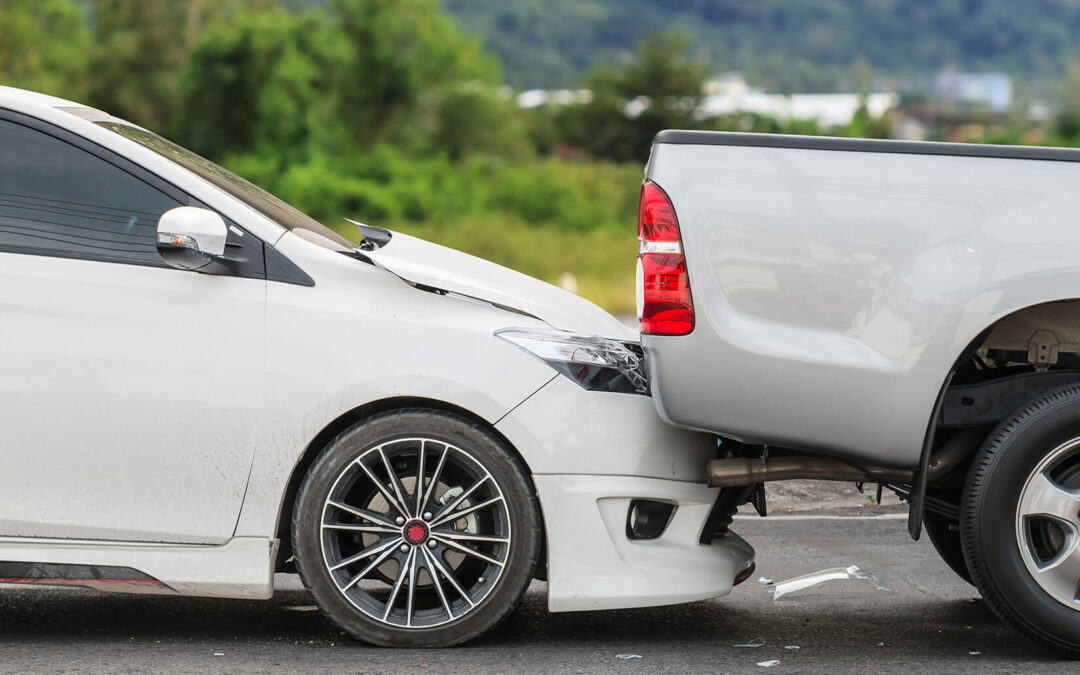The term “fender bender” itself is a bit of slang — catchy, rhyming, almost playful — which can make the damage sound minor. In this guide, we’ll discuss the types of repairs involved for a fender bender and a realistic repair timeline for an auto body shop to make the repairs. But brace yourself. Repairs might take longer than expected.
If You’ve Recently Been in a Fender Bender
Fender benders don’t just happen one way — they can occur in everyday driving situations, and most of us have experienced a fender bender at least once in our driving careers. Some of the most common include:
- Getting rear-ended while stopped at a light or in traffic
- Backing into another car in a cramped parking garage
- Scraping a bumper while pulling out of a tight space
- A slow-speed collision in a parking lot or driveway
- A minor tap at a stop sign when the car in front stops suddenly
The damage may look minor on the surface in each case, but repair times can vary depending on whether it’s a simple dent or if there is underlying damage below the surface.
What Qualifies as a Fender Bender?
A “fender bender” is a casual way of describing a low-speed, minor accident that causes dents or scratches to bumpers, exterior panels, cracked headlights or taillights, or scraped paint — the things that appear harmless enough at first. However, it’s essential to call the police and file a report, no matter how insignificant the damages initially appear. A police report is an official record of the accident that covers you in case your damages cost more than you thought due to rising parts prices and autobody work, in general.
What sets a fender bender apart from a more serious crash is that the car’s structural frame and safety systems — like airbags, suspension, or the engine — are usually unaffected. Still, it’s important not to dismiss them as insignificant. Fender benders can give you a false sense of security. Even minor fender bender accidents can cause hidden problems.
The worst-case scenario is when a seemingly minor fender bender cracks or bends the frame or damages hidden safety components in the car’s structure. These types of repairs are complex and costly since they affect the integrity of the whole vehicle.
Fender Bender Repair Timeline: Step-by-Step Repair Process
According to AutoBody News, the average repair time across all types of auto body work has climbed to 23.1 days, more than double what it was just a few years ago. While minor fender benders are often completed much sooner, the industry-wide data shows how parts delays and insurance approvals can quickly extend the timeline even for small fender benders.
Fender bender repair times and the collision’s severity can vary. A true ‘tap’ to your fender might only take a day to repair with paintless dent repair methods, which can save your car’s paint. However, more extensive repairs will take longer and depend on several variables, so you can expect to be without your vehicle for days, maybe even a week or more. Below are the basic timelines you can expect when getting your vehicle in for fender bender repairs.
1. Initial Assessment & Estimate (1–2 Days)
You should bring your vehicle into a collision repair shop to inspect the damage. The shop will then write up an estimate of parts and labor. The shop typically sends this directly to the adjuster if insurance is involved. Additionally, the repair team will disassemble the damaged area in case of any underlying damage that isn’t easily observed. A supplemental estimate is then sent to the insurer to cover all the repairs.
2. Insurance Approval (2–5 Days)
Repairs often can’t begin until the insurance company signs off on the estimate. This step may be quick, but it can also drag out if an adjuster needs to visit the shop in person or if there are disputes about what’s covered.
3. Parts Ordering & Delivery (3–7 Days)
If new parts are needed — bumpers, fenders, lights, or sensors — the shop places an order. Standard parts often arrive within a few days, but specialty or back-ordered items can take a week or more. This stage is one of the most significant factors determining how long a repair will take.
4. Bodywork & Structural Repairs (3–5 Days)
Once approval and parts are in hand, technicians get to work. They may repair or replace panels, straighten any bent metal, and ensure everything is structurally sound. This step might take only a day or two for a minor dent, but more complex damage can require several days.
5. Painting & Refinishing (2–3 Days)
If the paint has been scratched, cracked, or sanded down, the shop preps the surface and applies primer, color coats, and clear coats, then allows time for proper curing. Because drying and finishing happen in stages, even a small paint job often takes at least two days to complete.
6. Reassembly & Quality Check (1–2 Days)
After painting, the shop reassembles all parts, reconnects sensors, and ensures everything fits and functions properly. Most reputable shops also do a test drive and a final detailing before returning the car.
What Can Affect Your Repair Timeline?
Not every fender bender repair follows the same clock. A few key factors can shorten or stretch the timeline:
- Severity of the damage — Small dents without paint damage may only need PDR, while bent panels or cracked paint require longer repairs, or even replacement panels.
- Insurance approval — Delays often happen when adjusters are backed up or when questions arise about coverage.
- Parts availability — Common parts arrive quickly, but special orders or back-ordered components can add days or weeks.
- Auto body shop workload — Seasonal spikes (like hail damage in spring) can increase wait times.
Professional Body Shop Repair Services in Denver
A fender bender accident can seem harmless enough when it happens. But the real extent of the repairs needed can be deceiving. A little crunch or slight wrinkle in your fender requires as much repair as a major accident.
We’ve outlined the typical steps above to give drivers a clear picture of what to expect after a fender bender. If you’ve been in an accident in Denver or the surrounding area, Denver Auto Body and Paint brings decades of experience to every repair. You can receive a ballpark estimate for your repairs without ever leaving home. Just fill out our Get a Repair Quote form, and we’ll send you an initial estimate based on your details. Prefer to speak with someone directly? Call us at (303) 288-6263, and one of our technicians will answer your questions. You’re also welcome to stop by in person. We’re proud to be Denver’s trusted collision repair shop, restoring vehicles and confidence, one repair at a time.
Denver Auto Body is a premier collision repair center serving the Denver Metro area for over 35 years. As an I-CAR Gold Class and ASE Certified shop, we specialize in restoring vehicles to pre-accident condition using OEM parts. We prioritize safety, transparency, and expert insurance claim handling.


